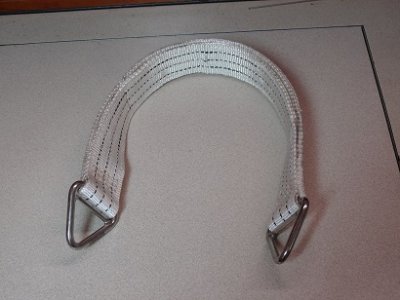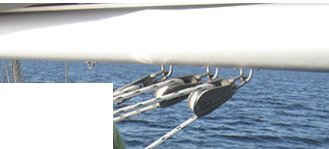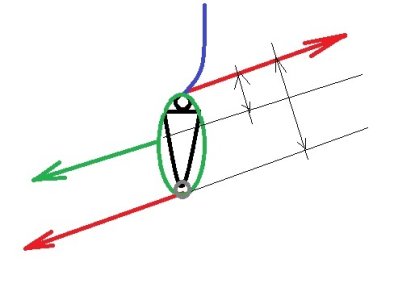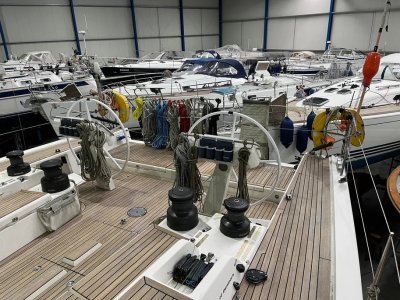Sea Change
Well-Known Member
The worst shock load of all would be a slack or stretchy preventer allowing the boom to swing so far that the preventer itself slammed against the shrouds.
That's exactly what John says in his article, and I think you and he are right.The worst shock load of all would be a slack or stretchy preventer allowing the boom to swing so far that the preventer itself slammed against the shrouds.
If you are attaching your preventer to the place where the main sheet attaches, then, even if it's a bit forward, presumably the boom is engineered to take the loads there.
i guess what i don't know is whether you have drawn the whole boom in your figure, or whether you have drawn just to where the main sheet attaches. I know you have said the boat has a short boom, but is it end-boom sheeting?
modern boats often have end-boom sheeting, and the boom is not really designed to take a bending moment forward.
But there is also another potential problem; the loads on the preventer itself
the further forward one attaches the preventer, the greater the potential loads.., irrespective of where the main sheet attaches.
so the next question is: is your preventer and all its attachments strong enough to take the load generated by that geometry? Your main sheet might be 4:1, or 8:1, is built with strong fittings, and is designed to handle the load..., whereas the preventer is probably a single line..., what are the fittings?
as shown above, the further out on the boom you can get the preventer attached, the lower the loads on that system, and the difference can be dramatic.



Interesting thread.The boat had several version and the sheet arrangement came in various types: end of boom tackle, two/third boom tackle (two multi sheaves blocks or various single sheave blocks spaced apart - which I have), even single sheet German, the boom can basically resist everything; the mainsail is relatively small by modern standards.
This is the boom strap I made for the preventer (should probably be enough to lift the boat), all the other components are roughly sized accordingly.
View attachment 192580
I also replaced all the mainsheet block attachment padeyes formerly located along the lower side of the boom with straps, when sailing downwind the blocks are free to turn around the boom so it removes a lot of the torque on the gooseneck; with all this talk of extraordinary loads, these attachments (for preventer, sheet blocks, etc) on the underside of the boom are a punch in the eye in engineering terms
View attachment 192588
View attachment 192589

That's a strong argument for a centre cockpit with boom-end sheeting, taken to a traveler aft of the cockpit.I don't have a good photo from the XP-55 I have been sailing on, without a lot of the crew, so I found a pic online that kind of shows what I am talking about above.
This is an XP-55, and it looks like the new Arcona 50 might have a similar setup.
the mainsheet is not rigged, but it attaches to the deck at the little thing in front of the cover for the emergency tiller.
note how when running, the main sheet is going to lie across the leeward winches and the bank of clutches, making this a very dangerous place to hang out. If you are on the windward winches trying to do something- the most comfortable side to be on, and the side without the mainsheet in the way - you are in the death zone for an accidental gybe...
That's a strong argument for a centre cockpit with boom-end sheeting, taken to a traveler aft of the cockpit.
Just preference, sailing single handed is about keeping things simple.Not sure I understand that statement - the injuries and fatalities generally occur AS the boom crosses the cockpit, not “after” as you suggest. Hence why most of us keep the preventer tight and rigged to the bow to prevent the boom sweeping the cockpit.
And separately you said that stopping the boom slatting is not necessary for you as “then you hoist the spinnaker and sheet in the mainsheet”, which again I struggle to understand.
Unless sailingna fast multihull or planning / foiling race boat, most cruisers tend to go best quite deep downwind, and don’t bring the apparent wind forward of the beam like very fast racers with asymmetrics. Therefore not clear why you would sheet in the mainsheet when setting a spinnaker?
Yes it's about keeping things safe, under control and as simple as possible to cope with the aforementioned. Simple is not always the best option and often leads to unfortunate consequences typically being responsible for many industrial "accidents"Just preference, sailing single handed is about keeping things simple.
A stock photo of the Swan 54 - but it happens to be the one I have sailed on
SafeER, not safe. I miss bikes, but they are unreasonably dangerous. I have enough scars, and will not go back to them, however much I would love to.I gave up motorcycling when I moved to Tenerife and often think about buying another. I know my limitations and how to keep myself safe, if I was at all reckless I would still be driving a motorcycle and sailing.